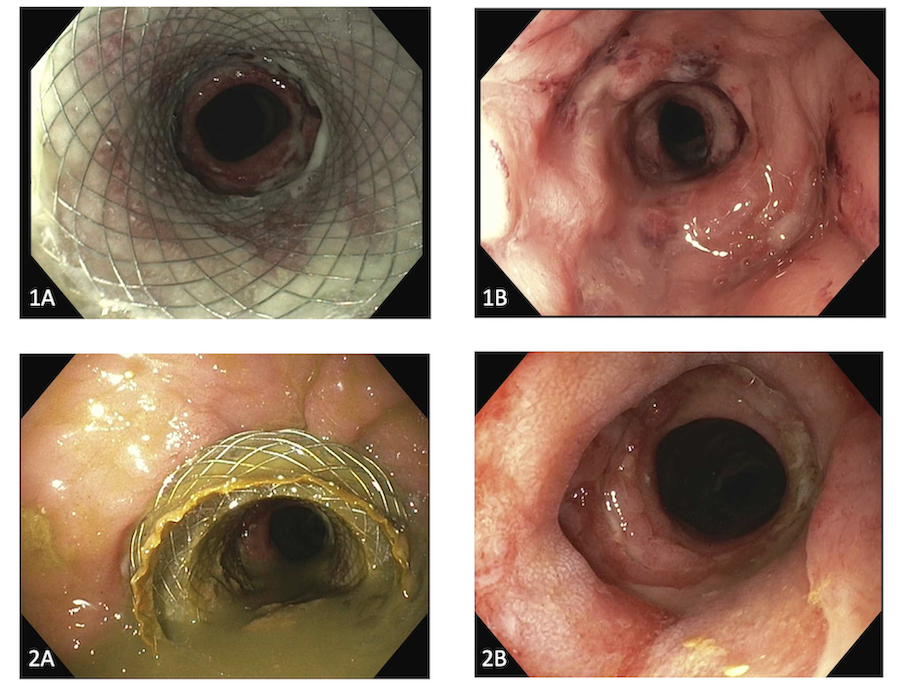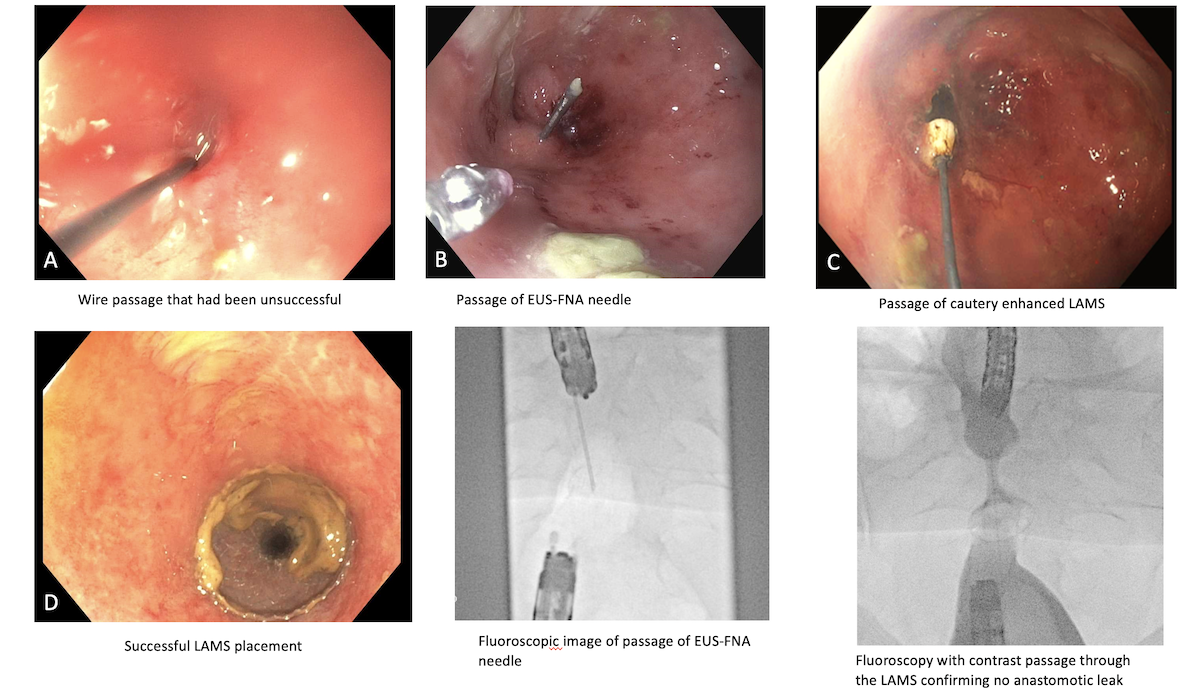Tuesday Poster Session
Category: Interventional Endoscopy
P5732 - Successful Treatment of a Benign Colocolonic Anastomotic Stricture With Free-Hand Creation of Luminal Patency Using Direct Needle Puncture Technique and Placement of Cautery-Enhanced Lumen Apposing Metal Stent (LAMS)
Tuesday, October 28, 2025
10:30 AM - 4:00 PM PDT
Location: Exhibit Hall
- AS
Ayushi Jayesh Shah, MD (she/her/hers)
SUNY Upstate Medical University
Syracuse, NY
Presenting Author(s)
Ayushi Jayesh. Shah, MD1, Sushrut Ingawale, MD, DNB, MBBS2, Abinash Subedi, MD1, Kelita Singh, MD1, Hafiz Muzaffar Akbar Khan, MD3
1SUNY Upstate Medical University, Syracuse, NY; 2Quinnipiac University - Frank H Netter MD School of Medicine, Bridgeport, CT; 3AdventHealth, Tampa, FL
Introduction: Treatment of colonic anastomotic strictures with LAMS has been described, but is dependent on the ability to pass at least a guidewire across the obstruction. We describe a patient with a benign occlusive colocolonic anastomotic stricture across which there was no contrast or wire passage, where we were able to create a freehand anastomosis across the lumen using a direct needle-puncture and cautery-enhanced lumen-apposing metal stent (LAMS).
Case Description/
Methods: A 33-year-old man with a history of diverticular disease treated with left hemicolectomy and temporary diverting ileostomy presented for endoscopic management of a colocolonic (transverse to sigmoid colon) anastomotic stricture that had recurred despite prior endoscopic therapy and surgical revision. He presented to the OR for a colonoscopy where a colonoscope was passed through the ileostomy and advanced to the stricture, which was 15 mm (length) and 2 mm (diameter). An endoscope was passed through the rectum by an assisting surgeon. Many guidewires varying in diameter, stiffness and angulation, and contrast did not pass through the tortuous, occluded stricture. A successful direct needle-puncture was done using a 19-gauge EUS-FNA needle under endoscopic and fluoroscopic guidance; 0.018-inch guidewire was passed through the needle. A cautery-enhanced 15 mmx15 mm LAMS was deployed over the wire under endoscopic and fluoroscopic guidance (Figure 1). The patient was given 3 days of oral ciprofloxacin, and he tolerated a low-residue diet next day after which he was discharged. At 6-week follow-up, there was improvement in the stricture with luminal diameter to 1.2 cm. A cold LAMS 15 mm X 15 mm was placed until ileostomy reversal. The patient returned after ileostomy reversal and 8 weeks from last colonoscopy and underwent removal of the LAMS with resolution of the stricture (Figure 2). At 4 month follow up, the patient reported no obstructive symptoms.
Discussion: In our case, the luminal stenosis was severe, limiting the passage of a wire or contrast. Our case is the first to describe the creation of a free-hand anastomosis in a completely occluded colonic stricture using this technique of direct needle puncture and cautery-enhanced LAMS. There was technical and clinical success in restoring luminal patency with this technique using antegrade and retrograde endoscopic and fluoroscopic guidance. Cautious reproducibility in well-selected cases may be possible and further studies are needed to study the safety of this technique.

Figure: Endoscopic and fluoroscopic images of colonoscopy showing direct-needle puncture technique with successful creation of colo-colonic anastomosis across the occluded stricture

Figure: 1A and 1B: Endoscopic images of follow-up colonoscopy at 6 weeks, and improvement in stricture after removal of the LAMS.
2A and 2B: Endoscopic images of second follow-up colonoscopy at 8 weeks showing resolution of the stricture
Disclosures:
Ayushi Shah indicated no relevant financial relationships.
Sushrut Ingawale indicated no relevant financial relationships.
Abinash Subedi indicated no relevant financial relationships.
Kelita Singh indicated no relevant financial relationships.
Hafiz Muzaffar Akbar Khan indicated no relevant financial relationships.
Ayushi Jayesh. Shah, MD1, Sushrut Ingawale, MD, DNB, MBBS2, Abinash Subedi, MD1, Kelita Singh, MD1, Hafiz Muzaffar Akbar Khan, MD3. P5732 - Successful Treatment of a Benign Colocolonic Anastomotic Stricture With Free-Hand Creation of Luminal Patency Using Direct Needle Puncture Technique and Placement of Cautery-Enhanced Lumen Apposing Metal Stent (LAMS), ACG 2025 Annual Scientific Meeting Abstracts. Phoenix, AZ: American College of Gastroenterology.
1SUNY Upstate Medical University, Syracuse, NY; 2Quinnipiac University - Frank H Netter MD School of Medicine, Bridgeport, CT; 3AdventHealth, Tampa, FL
Introduction: Treatment of colonic anastomotic strictures with LAMS has been described, but is dependent on the ability to pass at least a guidewire across the obstruction. We describe a patient with a benign occlusive colocolonic anastomotic stricture across which there was no contrast or wire passage, where we were able to create a freehand anastomosis across the lumen using a direct needle-puncture and cautery-enhanced lumen-apposing metal stent (LAMS).
Case Description/
Methods: A 33-year-old man with a history of diverticular disease treated with left hemicolectomy and temporary diverting ileostomy presented for endoscopic management of a colocolonic (transverse to sigmoid colon) anastomotic stricture that had recurred despite prior endoscopic therapy and surgical revision. He presented to the OR for a colonoscopy where a colonoscope was passed through the ileostomy and advanced to the stricture, which was 15 mm (length) and 2 mm (diameter). An endoscope was passed through the rectum by an assisting surgeon. Many guidewires varying in diameter, stiffness and angulation, and contrast did not pass through the tortuous, occluded stricture. A successful direct needle-puncture was done using a 19-gauge EUS-FNA needle under endoscopic and fluoroscopic guidance; 0.018-inch guidewire was passed through the needle. A cautery-enhanced 15 mmx15 mm LAMS was deployed over the wire under endoscopic and fluoroscopic guidance (Figure 1). The patient was given 3 days of oral ciprofloxacin, and he tolerated a low-residue diet next day after which he was discharged. At 6-week follow-up, there was improvement in the stricture with luminal diameter to 1.2 cm. A cold LAMS 15 mm X 15 mm was placed until ileostomy reversal. The patient returned after ileostomy reversal and 8 weeks from last colonoscopy and underwent removal of the LAMS with resolution of the stricture (Figure 2). At 4 month follow up, the patient reported no obstructive symptoms.
Discussion: In our case, the luminal stenosis was severe, limiting the passage of a wire or contrast. Our case is the first to describe the creation of a free-hand anastomosis in a completely occluded colonic stricture using this technique of direct needle puncture and cautery-enhanced LAMS. There was technical and clinical success in restoring luminal patency with this technique using antegrade and retrograde endoscopic and fluoroscopic guidance. Cautious reproducibility in well-selected cases may be possible and further studies are needed to study the safety of this technique.

Figure: Endoscopic and fluoroscopic images of colonoscopy showing direct-needle puncture technique with successful creation of colo-colonic anastomosis across the occluded stricture

Figure: 1A and 1B: Endoscopic images of follow-up colonoscopy at 6 weeks, and improvement in stricture after removal of the LAMS.
2A and 2B: Endoscopic images of second follow-up colonoscopy at 8 weeks showing resolution of the stricture
Disclosures:
Ayushi Shah indicated no relevant financial relationships.
Sushrut Ingawale indicated no relevant financial relationships.
Abinash Subedi indicated no relevant financial relationships.
Kelita Singh indicated no relevant financial relationships.
Hafiz Muzaffar Akbar Khan indicated no relevant financial relationships.
Ayushi Jayesh. Shah, MD1, Sushrut Ingawale, MD, DNB, MBBS2, Abinash Subedi, MD1, Kelita Singh, MD1, Hafiz Muzaffar Akbar Khan, MD3. P5732 - Successful Treatment of a Benign Colocolonic Anastomotic Stricture With Free-Hand Creation of Luminal Patency Using Direct Needle Puncture Technique and Placement of Cautery-Enhanced Lumen Apposing Metal Stent (LAMS), ACG 2025 Annual Scientific Meeting Abstracts. Phoenix, AZ: American College of Gastroenterology.
